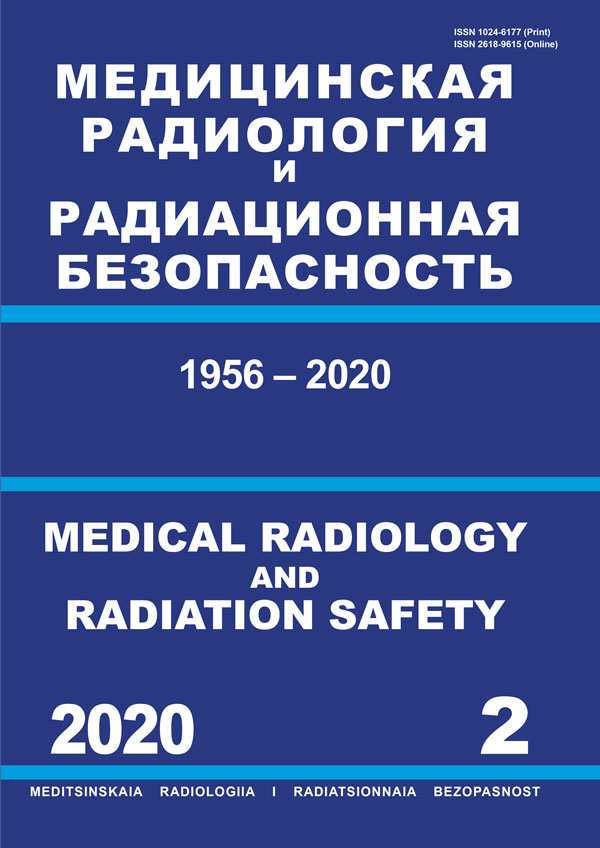Russian Federation
Russian Federation
CSCSTI 76.03
CSCSTI 76.33
Russian Classification of Professions by Education 14.04.02
Russian Classification of Professions by Education 31.06.2001
Russian Classification of Professions by Education 31.08.08
Russian Classification of Professions by Education 32.08.12
Russian Library and Bibliographic Classification 51
Russian Library and Bibliographic Classification 534
Russian Trade and Bibliographic Classification 5708
Russian Trade and Bibliographic Classification 5712
Russian Trade and Bibliographic Classification 5734
Russian Trade and Bibliographic Classification 6212
Purpose: Development of a method of chemical sample preparation to reduce the lower limit of the absorbed dose estimation by EPR spectrometry. Material and methods: The required number of bone samples was prepared to study the effect of chemical treatment of bone material samples in organic solvents on their EPR spectra. They were subjected to primary treatment to separate the bones from the remains of soft biological tissue, then a dense bone was isolated and its defatting was carried out. Further, a series of parallel experiments on chemical treatment of bone materials in solutions of three organic reducing agents (hydrazine hydrate, ethylenediamine and diethylenetriamine) were done to reduce the magnitude of the native signal when carrying out works on reconstruction of absorbed doses using EPR spectroscopy. Recording of EPR spectra was performed on the ELEXSYS E500 Bruker spectrometer equipped with a high-q cylindrical resonator SHQE. Irradiation of the samples was carried out on the X-ray biological unit RUB RUST-M1. Results: To reduce the lower limit of detection of the absorbed dose and improve the reliability of the assessment of the absorbed dose using the EPR method, it is required to reduce the native component of the EPR signal without affecting, if possible, the radiation component of the EPR signal. To achieve this effect, a chemical treatment in solutions of amines was proposed, which affect the collagen compounds that present in the bones and which are responsible for the appearance of a native signal in the EPR spectrum. After chemical treatment of bone material samples at 30°C for 30 minutes in a solution of different amines, there was a significant decrease in the amplitude of the native signal, which was: 4 for hydrazine hydrate, 3.3 for diethylenetriamine and 2.1 for ethylenediamine. For bone material samples that were subjected to the proposed chemical treatment in hydrazine hydrate, it is possible to confidently determine the amplitude of the radiation signal by a value of 2–3 Gy against the minimum dose values of 6–8 Gy for bone material samples that were not chemically treated. Conclusion: It was found that during the chemical treatment there is a significant reduction of the native signal in the spectra of EPR of bone materials, the decrease of the radiation signal at the same time was slightly. Comparison of the results of treatment of bone materials in three organic reducing agents showed that the best results are obtained by the use of hydrazine hydrate at a temperature of 30°C for 30 minutes.
Electron Paramagnetic Resonance, radiation signal, native signal, absorbed dose, bone, chemical treatment
1. Local Radiation Injuries in: Radiation Medicine. A Guide for Medical Researchers and Health Care Organizers. Ed. by L. A. Ilyin. Vol. 2. - Moscow. IzdAt, 2001:161-202. (in Russ.).
2. Barabanova AV, Baranov AE, Bushmanov AYu, Guskova AK. Radiation damage to humans. Selected clinical lectures, methodological guide. Eds. by AYu Bushmanov, VD Reva. Moscow, 2007. (in Russ.).
3. Nadezhina NM, Galstyan IA, Sachkov AV, Malinovskaya IA. Prospects for the diagnosis and treatment of local radiation injuries. Medical Radiology and Radiation Safety. 2004:49(4):21-8. (in Russ.).
4. Galstyan IA, Ilevich YuR, Kleshchenko ED, et al. Possibilities of retrospective dose estimation in radiation injuries. Medical Radiology and Radiation Safety. 2004;49(5):5-13. (in Russ.).
5. Nadezhina NM, Barabanova AV, Galstyan IA. Difficulties in diagnosis and treatment of victims of exposure to lost sources of ionizing radiation. Medical Radiology and Radiation Safety. 2005;50(4):15-20. (in Russ.)].
6. Barabanova AV. Local radiation lesions of the skin. Medical Radiology and Radiation Safety. 2010;55(5):79-84. (in Russ.)].
7. Kozitsyna AN, Ivanova AV, Glazyrina YA, Tsmokalyuk AN, Ivoylova AV, Petrov AS. EPR spectroscopy, electrochemical and combined methods of analysis. Training manual. Ed. by AYu Glazyrina. Ekaterinburg: publishing House of Ural University, 2018. 60 p. (in Russ.).
8. Ikeya M. New applications of electron spin resonance: dating, dosimetry and microscopy. Singapore; River Edge: World Scientific, 1993. 500 p.
9. Samoylov AS, Bushmanov AY, Galstyan IA, Nadezhina NA, Pantelkin VP, Aksenenko AV, et al. Local radiolesion in X-ray inspection specialists. Radiation Protection Dosimetry. 2016;171(1):117-20.
10. The Radiological Accident in Lia, Georgia. Vienna: International Atomic Energy Agency, 2014.
11. Fattibene P, Callence F. EPR dosimetry with tooth enamel: A review. Appl Radiat and Isotopes. 2010;68(11):2033-116.
12. Skripnik DG. Effect of physical and chemical treatment of human tooth enamel on the EPR signal. Abstract of thesis for the degree of PhD Chem, Obninsk, 2004, 23 p. (in Russ.)].





